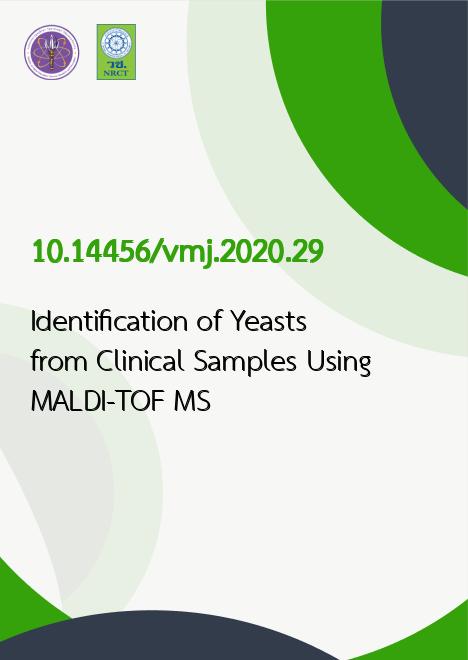
|
Identification of Yeasts from Clinical Samples Using MALDI-TOF MS |
|---|---|
| รหัสดีโอไอ | |
| Creator | 1. Chanika Maenchantrarath 2. Daranee Nutalai 3. Worada Samosornsuk 4. Prirayapak Sakoonwatanyoo |
| Title | Identification of Yeasts from Clinical Samples Using MALDI-TOF MS |
| Publisher | Text and Journal Publication |
| Publication Year | 2563 |
| Journal Title | Vajira Medical Journal |
| Journal Vol. | 64 |
| Journal No. | 4 |
| Page no. | 297-310 |
| Keyword | Conventional method, MALDI-TOF MS, Extended direct transfer technique |
| URL Website | https://tci-thaijo.org/index.php/VMED |
| Website title | Vajira Medical Journal (วชิรเวชสาร) |
| ISSN | 0125-1252 |
| Abstract | Objective: This research aimed to identify the yeasts from the clinical specimens by comparing MALDI-TOF MS using extended direct transfer technique (EDT-MALDI) and the conventional method. Methods: This study was a retrospective cohort. The samples were the 557 yeasts isolated from the clinical specimens in the Faculty of Medicine Vajira Hospital, Navamindradhiraj University, Thailand by comparing between the EDT-MALDI and the conventional method. The data were analyzed by using McNemar Test. Moreover, the unit cost and the turnaround time of the both methods were calculated. The other data such as age, sex, wards, types of the specimens and the prevalence of the species of yeasts, were collected and analyzed. Results: The result showed that the EDT-MALDI can identify the yeast isolates into the species level more accurately than the conventional method at 100% and 93.2%, respectively. The conventional method was limited for correctly identification of Trichosporon asahii, Cryptococcus neoformans, some non-albicans Candida, Magnusiomyces capitatus, and Candida rugosa. However, both methods were not significantly different from each other. Even though the threshold score of the EDT-MALDI was reduced from ? 2 to ? 1.7, this will increase the acceptable results without effect to specificity, accuracy, and reliability in the species level. The EDT-MALDI was faster than the conventional method for at least 24 hours. Moreover, the unit cost of EDT-MALDI is lower than the conventional method (68 baht/test and 116 baht/test, respectively). In this data, the elderly female admitted to the hospital were the most patients who found yeast in specimens. Candida albicans (54.04%) were the most isolated species, followed by Candida tropicalis (26.21%). Conclusion: The EDT-MALDI was a suitable method for the yeast identification in the routine laboratory because it was provided a shorter time of analysis, obtained reliable results and less expensive unit cost. |